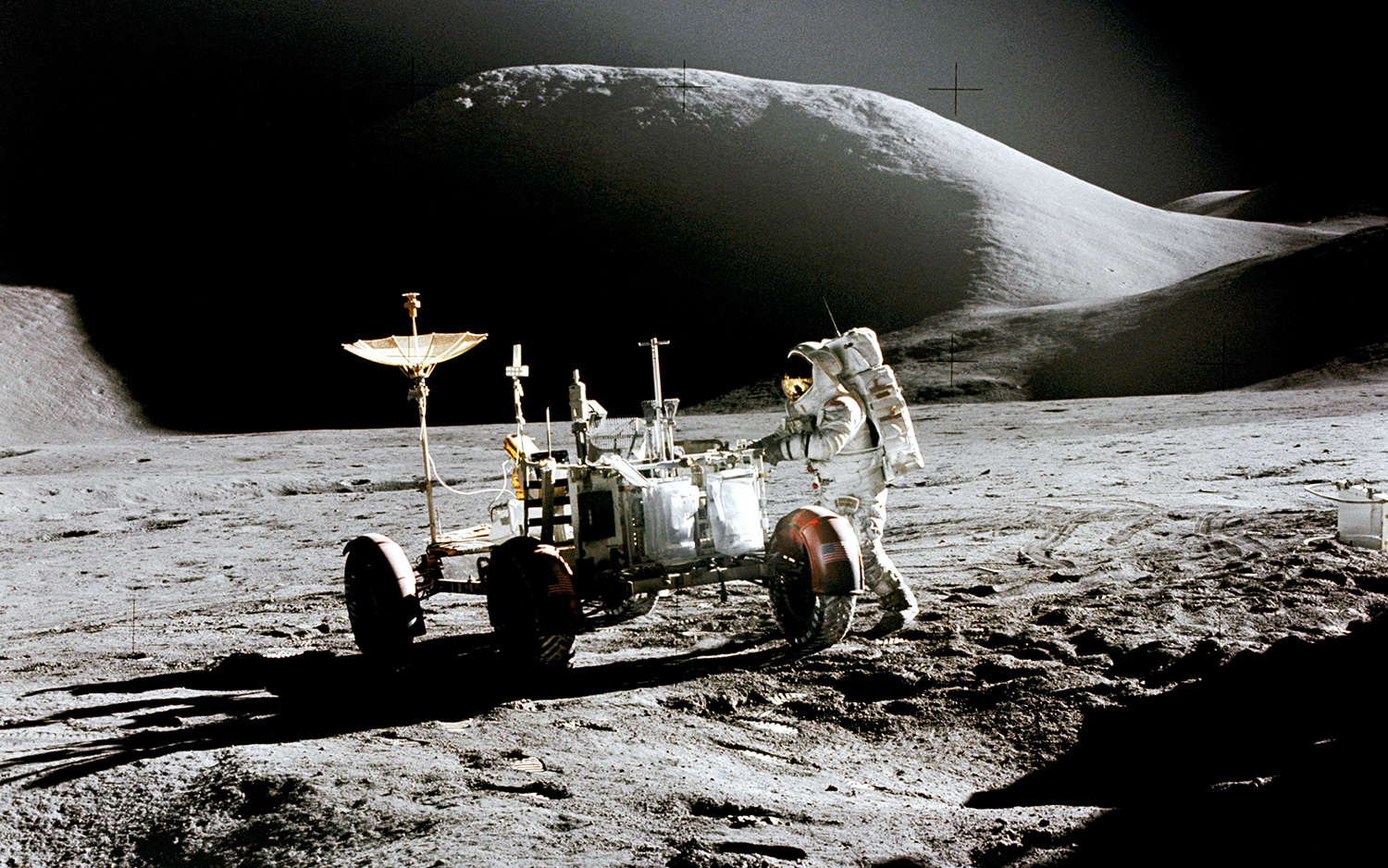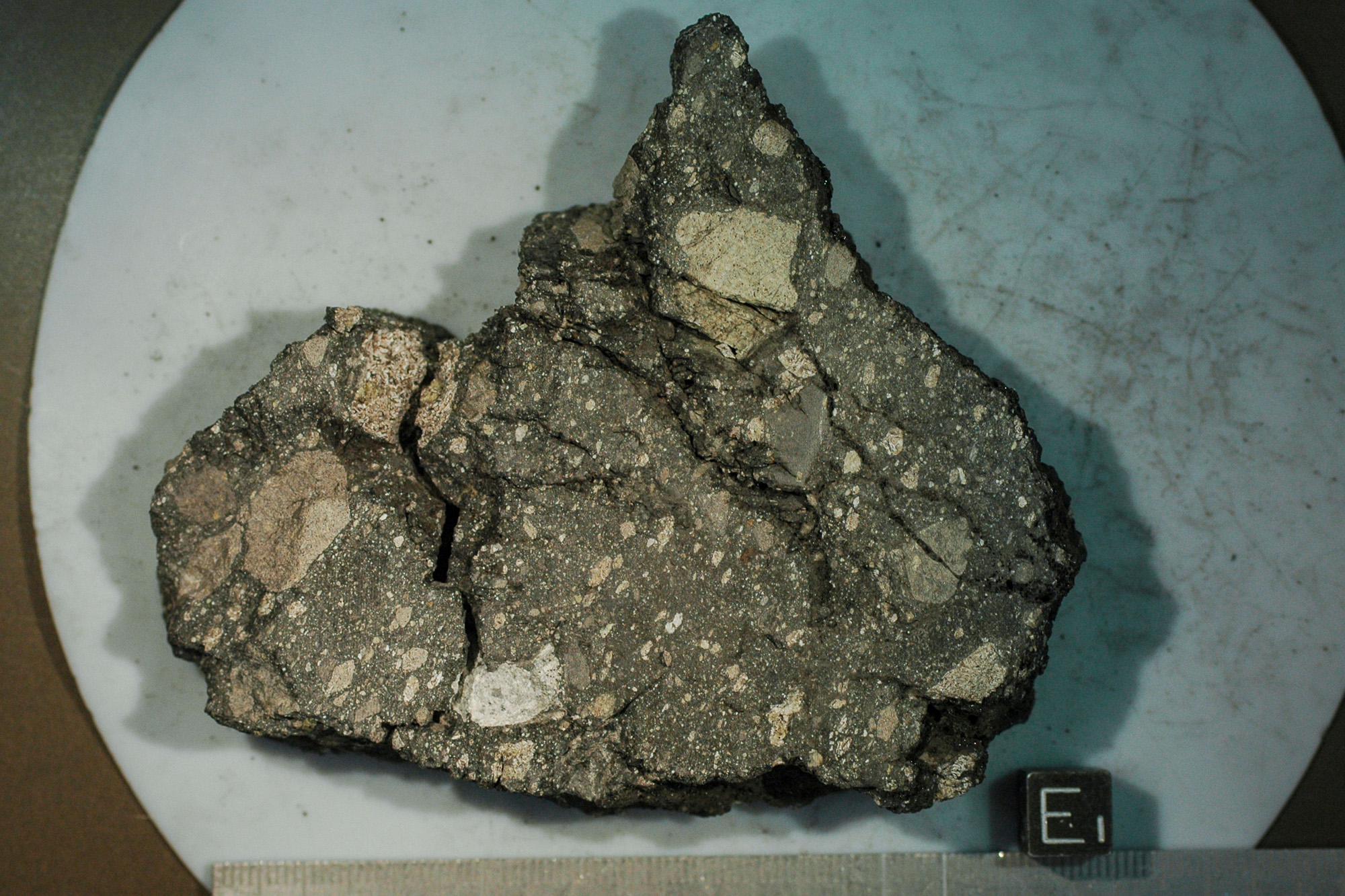Apollo 15: The Moon Buggy Debuts
Apollo 15, which launched on July 26, 1971, marked the beginning of NASA's most challenging crewed missions to the moon. This mission featured the longest stay yet on the lunar surface, three moonwalks and the first use of a "moon buggy," or lunar rover. Only two more crewed missions followed after Apollo 15: Apollo 16 and Apollo 17.
In the training for Apollo 15, the mission's three astronauts put an emphasis on geological work. They spent many hours in the field learning how to identify different types of rocks and formations. The crew, all U.S. Air Force pilots, had trained together in the past, all serving as backups for the Apollo 12 mission.
Cmdr. Dave Scott had two spaceflight missions under his belt. He was the command module pilot on Apollo 9, which featured the first Apollo docking in space. He also flew on an eventful Gemini mission in 1966. Gemini 8 had a malfunctioning thruster that spun the spacecraft around so quickly that the astronauts almost lost consciousness; crewmate Neil Armstrong managed to pull Gemini 8 out of the lurch by activating the re-entry system. [Apollo 15 in Photos: A Moon Landing and the 1st Lunar Car for Astronauts]
Jim Irwin was the lunar module pilot for Apollo 15, and Al Worden was the command module pilot. Previous to NASA, Irwin was an experimental test pilot and F-12 pilot with the Air Force, while Worden was an instructor at the Aerospace Research Pilot School with the U.S. Air Force. Apollo 15 was the only spaceflight for each of these astronauts.

A rocky test drive
After several missions of choosing progressively challenging landing sites, NASA wanted to aim even higher for Apollo 15. NASA described the site it came up with for the landing — Hadley Rille, on the edge of Mare Imbrium — as "spectacularly beautiful." More importantly, it was a treasure trove of geologic treasure, including mountains, craters and Hadley — a large canyon.
Unlike the other Apollo crews, Apollo 15 astronauts chose to sleep after their landing, which occurred on July 30, instead of doing a moonwalk right away. The time to rest helped the crew preserve their energy for the longer mission. Before hitting the sack, Scott opened the hatch at the top of the lunar lander, Falcon, and took a series of camera shots to get a panoramic view of the site.
The next morning, Scott hopped down the ladder and looked at the field site surrounding him. "Man must explore. And this is exploration at its greatest," he said. Then, he and Irwin got to work unfolding the lunar roving vehicle from the side of Falcon.
Next came a test drive. It was no surprise that driving was a bumpy experience, given all the rocks and mini-divots in the moon's surface. While the front-wheel drive wasn't working, Scott found he could manage with only the rear-wheel-drive system.
The astronauts drove the rover a total of 17.5 miles (28 kilometers). The crew had one main complaint: the seat belts, which were difficult to get on and off, because lunar gravity did not push the astronauts down easily to allow them to fasten the seatbelt over their spacesuits. [Driving on the Moon: The 40-Year Legacy of NASA's First Lunar Car]
Scientific discovery
Irwin and Scott were on the hunt for anorthosites, which are believed to be the moon's oldest rocks, and the astronauts found the material in spades during the second day on the lunar surface. At Spur Crater, the astronauts picked up four of these types of rocks. The most well-known of the bunch was later dubbed the Genesis Rock because of its ancient age, some 4.5 billion years old.
Back at Falcon, Scott was supposed to drill down below the moon's surface to get a "core sample" that would show the layers of rock underneath the surface. The regolith was packed tight, and it was hard to get the drill in far enough. Scott, who was tired from 7 hours of work outside, didn't have the energy to pull the drill back out.
NASA ordered him to leave it until the next day. After Irwin and Scott went outside for their third spacewalk, both of them struggled to withdraw the core, but they succeeded.
After a geological-focused trip to Hadley Rille, the astronauts returned to their lunar lander, Antares. Scott then did a mini scientific experiment in front of the TV camera in honor of Galileo Galilei, dropping a feather and hammer on the lunar surface. Galileo is said to have dropped weights from the Leaning Tower of Pisa in the 1600s to demonstrate that objects of different mass fall at the same rate.
When Scott's feather and hammer struck regolith at the same time, mission controllers applauded. "Nothing like a little science on the moon," Scott said.
While Scott and Irwin toiled on the surface, Worden contributed his own observations from above. From the command module Endeavour, Worden excitedly described a crater called Littrow, which scientists of the time believed may have once been part of a volcanic region. Later, Apollo 17 landed at Littrow.
The crew left the surface of the moon on Aug. 2, and for the first time, the liftoff was seen on Earth, broadcast via the television camera on the lunar rover. Just before they left lunar orbit, the crew launched the Particles and Fields satellite. This craft was designed to investigate the moon's mass and gravitational variations, the particle composition of space near the moon, and the interaction of the moon's magnetic field with that of Earth.
All told, Apollo 15's moon-roving astronauts spent 18 hours 37 minutes working on the lunar surface, almost the total time spent in lunar orbit by the Apollo 8 crew. The Apollo 15 team set other records as well, including longest time in lunar orbit (about 145 hours) and longest lunar mission (295 hours). The crew returned to Earth Aug. 7, bringing back a geologic bonanza for scientists and positioning NASA for more-ambitious missions to come.

Apollo 15 legacy
Endeavour is at the National Museum of the U.S. Air Force at Wright-Patterson Air Force Base in Dayton, Ohio, while the upper stage of Falcon hit the moon (as planned) on Aug. 3, 1971. The 50th anniversary of the Apollo 15 mission is in 2021.
Apollo 15 kicked off the most ambitious lunar landings, with the remaining crews spending several days on the moon's surface and hauling home rocks of many different kinds. NASA, however, elected to focus on low Earth orbit starting in the mid-1970s. Some of the agency's most famous programs in that field include the space shuttle (1981-2011) and the International Space Station (1998 to present).
The agency is expected to return humans to the moon in the 2020s, at least if the current policy of President Donald Trump's administration holds. In preparation for that effort, NASA is working on a space station concept called the Deep Space Gateway. The agency is also testing out Orion, a deep-space spacecraft, and a rocket called the Space Launch System. NASA may also go to Mars in the 2030s or 2040s, if funding and current plans hold.
Join our Space Forums to keep talking space on the latest missions, night sky and more! And if you have a news tip, correction or comment, let us know at: community@space.com.
Get the Space.com Newsletter
Breaking space news, the latest updates on rocket launches, skywatching events and more!

Elizabeth Howell (she/her), Ph.D., was a staff writer in the spaceflight channel between 2022 and 2024 specializing in Canadian space news. She was contributing writer for Space.com for 10 years from 2012 to 2024. Elizabeth's reporting includes multiple exclusives with the White House, leading world coverage about a lost-and-found space tomato on the International Space Station, witnessing five human spaceflight launches on two continents, flying parabolic, working inside a spacesuit, and participating in a simulated Mars mission. Her latest book, "Why Am I Taller?" (ECW Press, 2022) is co-written with astronaut Dave Williams.










